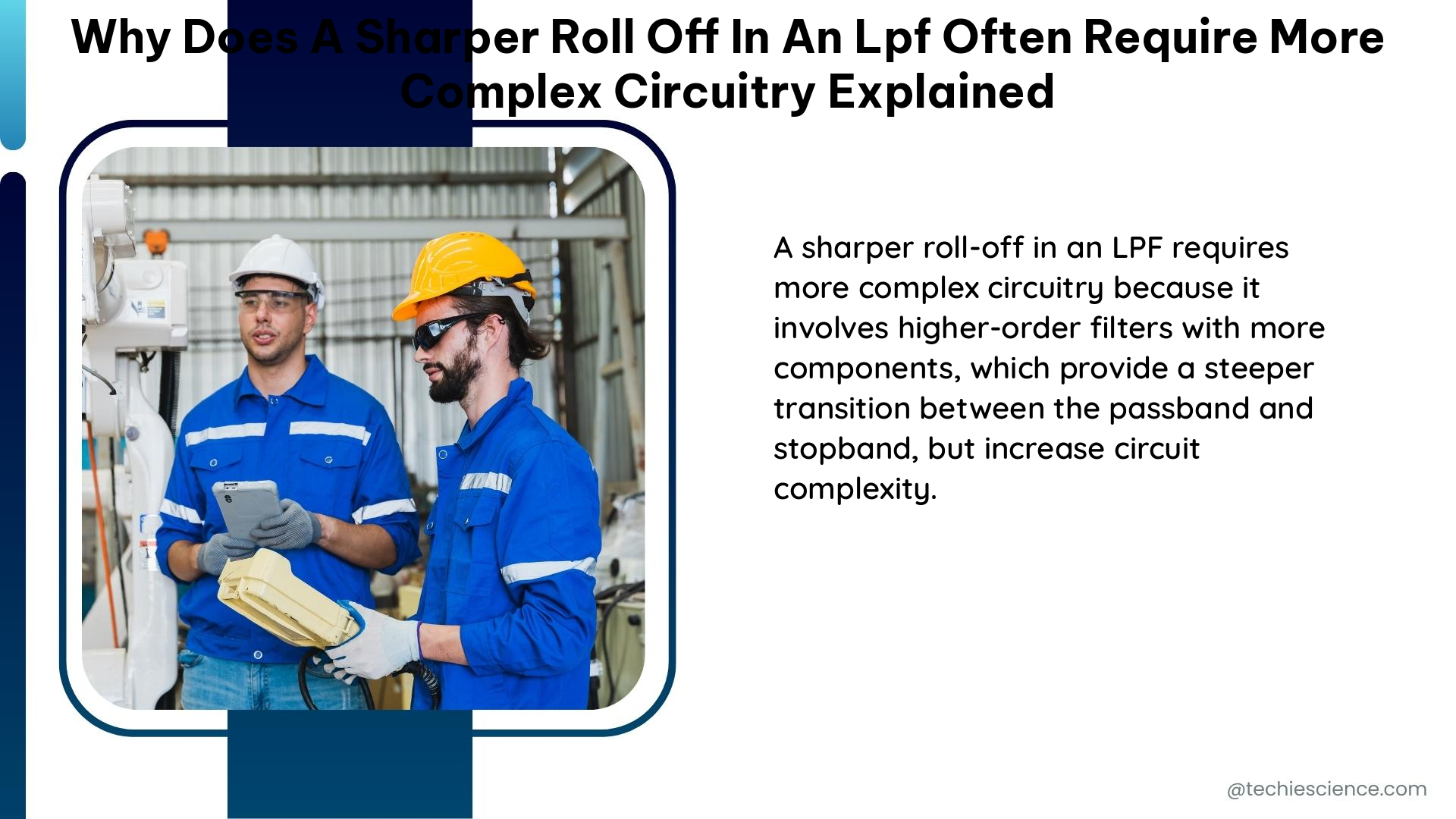A sharper roll-off in a Low-Pass Filter (LPF) often requires more complex circuitry due to the increased order of the filter necessary to achieve the desired steepness in the transition between the passband and the stopband. The roll-off rate is a measure of this steepness and is typically given in units of decibels per decade (dB/decade) or decibels per octave (dB/8ve).
Understanding the Roll-Off Rate of a First-Order LPF
For a simple first-order network, such as an RC circuit, the roll-off rate is 20 dB/decade, or approximately 6 dB/octave. This can be shown by analyzing the voltage transfer function of the RC network, which is given by:
A = V₀/Vᵢ = 1/(1 + iωRC)
When frequency scaling this equation to ωc = 1/RC = 1 and forming the power ratio, we get:
|A|² = 1/(1 + ω²)
In decibels, this becomes:
L = 10log(1 + ω²) dB
At frequencies well above ω=1, this simplifies to:
L ≈ 20logω dB
The roll-off is given by:
ΔL = 20log(ω₂/ω₁) dB/interval₂₁
For a decade, this is:
ΔL = 20log10 = 20 dB/decade
and for an octave,
ΔL = 20log2 ≈ 20 × 0.3 = 6 dB/8ve
Achieving a Sharper Roll-Off with Higher-Order Filters

To achieve a sharper roll-off, a higher order filter is necessary. This can be accomplished by cascading multiple first-order sections or by using more complex filter topologies, such as a second-order Butterworth or Chebyshev filter. These higher order filters require more components and more complex circuitry to implement, which is why a sharper roll-off often requires a more complex circuit.
Butterworth Filters
Butterworth filters are a type of analog filter designed to have a maximally flat frequency response in the passband. The transfer function of a Butterworth filter is given by:
H(s) = 1 / (1 + (s/ωc)^(2n))
where ωc is the cutoff frequency and n is the filter order. As the order of the Butterworth filter increases, the roll-off rate becomes sharper, but the complexity of the circuit also increases.
For example, a second-order Butterworth filter has a roll-off rate of 40 dB/decade, while a fourth-order Butterworth filter has a roll-off rate of 80 dB/decade. The higher-order filters require more components, such as additional capacitors and inductors, to achieve the desired roll-off characteristics.
Chebyshev Filters
Chebyshev filters are another type of analog filter that can achieve a sharper roll-off than Butterworth filters. The transfer function of a Chebyshev filter is given by:
H(s) = 1 / (1 + ε²Tn²(s/ωc))
where ε is the passband ripple factor, Tn(x) is the Chebyshev polynomial of degree n, and ωc is the cutoff frequency. Chebyshev filters can achieve a sharper roll-off than Butterworth filters, but they have a non-flat passband response and exhibit ripple in the passband.
Similar to Butterworth filters, higher-order Chebyshev filters require more components and more complex circuitry to implement, which is why a sharper roll-off often requires a more complex circuit.
Challenges in Designing Passive Filters with Sharp Cutoff
In addition to the complexity of active filters, passive filters with a sharp cutoff are also challenging to design and implement. For higher-order passive filters (= sharper cut-off), you need both inductors and capacitors. There’s no way around it, and the mathematics concerning this subject have been around for centuries.
The “trick” for achieving a sharper cutoff in a passive filter is to use a ladder topology, where the resistors increase by a large factor from the input end to the output end, with capacitors scaling in the opposite direction for equal time constants. This ladder topology helps to create a sharper roll-off, but it also increases the complexity of the circuit.
Conclusion
In summary, a sharper roll-off in an LPF often requires more complex circuitry due to the increased order of the filter necessary to achieve the desired steepness in the transition between the passband and the stopband. This can be accomplished through the use of higher-order filters, such as a second-order Butterworth or Chebyshev filter, or through the use of more complex filter topologies, such as a ladder topology in passive filters. The increased complexity is necessary to overcome the inherent limitations of first-order filters and achieve the desired sharp roll-off characteristics.
References:
– Reconfigurable Low-Pass Filter With Sharp Roll-Off and Wide Tuning Range, https://www.researchgate.net/publication/341924121_Reconfigurable_Low-Pass_Filter_With_Sharp_Roll-Off_and_Wide_Tuning_Range
– A Microstrip Lowpass Filter With Wide Tuning Range and Sharp Roll-Off Response, https://ieeexplore.ieee.org/document/9055439
– How to Increase the Roll-Off Rate, https://forum.allaboutcircuits.com/threads/how-to-increased-the-roll-off-rate.35996/
– Roll-off – Wikipedia, https://en.wikipedia.org/wiki/Roll-off
– Is there a way I can get a “sharper” cut-off/slope from a passive Low Pass Filter?, https://www.eevblog.com/forum/beginners/is-there-a-way-i-can-get-a-sharper-cut-offslope-from-a-passive-low-pass-fil/

The lambdageeks.com Core SME Team is a group of experienced subject matter experts from diverse scientific and technical fields including Physics, Chemistry, Technology,Electronics & Electrical Engineering, Automotive, Mechanical Engineering. Our team collaborates to create high-quality, well-researched articles on a wide range of science and technology topics for the lambdageeks.com website.
All Our Senior SME are having more than 7 Years of experience in the respective fields . They are either Working Industry Professionals or assocaited With different Universities. Refer Our Authors Page to get to know About our Core SMEs.